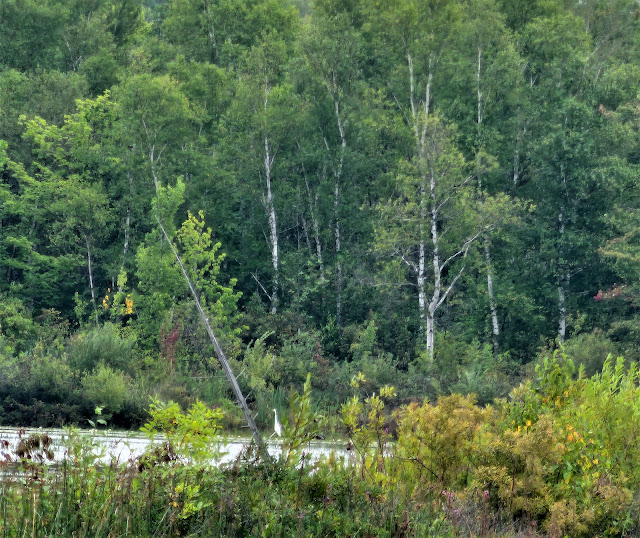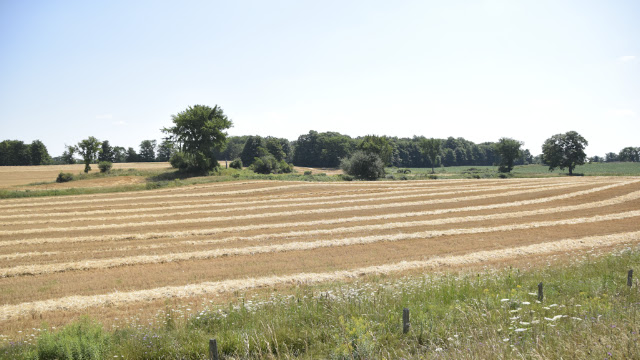Most days when I go down to the harbour I see the boats of our local sailing school, Sail Georgian Bay, in action. Often they're beyond my view out on the open bay, but when the waves are too choppy they're in the inner harbour, practicing their skills. It turns out that they have more skills than I realized!
Monday, August 28, 2023
Sail Georgian Bay Does Well!
Friday, August 25, 2023
The Seasons They Are A 'Changin'!
The early signs of fall are all around us. I can't believe the beautiful summer I enjoy so much is nearly over. It feels like it's over already. For now I see the changes in the garden, in the weather, and on the drives we do through the countryside. In 6 weeks I'll see it in the coloured leaves of our real fall here.
The garden has changed from Day Lilies, Lavender and Clematis to Echinacea and Zinnias, of which these two are just samples.And other less common flowers like these Helenium, one of my favourites. It's one of the Sneezeweeds, a name which doesn't do justice to its delicate beauty.
And yes, the Day Lilies, star of the show for our garden, are pretty well over. These very dark purple ones are about the last.
Elsewhere, as I ride down the Collingwood St. hill, and as we drive round the countryside, the goldenrods are stars of the late summer show.
And all manner of different trees and shrubs are laden with berries, as I showed you a couple of posts back. These are Mountain Ash berries, at the edge of the parking lot by the new physio clinic I go to.
The very few trees showing a little colour here are still few and far between, but come October they'll be the stars of the show.
Tuesday, August 22, 2023
Great Egrets, Swans and a Kingfisher
We turned around where the church and an old one-room school marked the the Shouldice corner and headed back down the narrow gravel road, probably only used by farm equipment. Drove down through the swamp again in the opposite direction, and this time we did spot some birds.
Great Egrets are Blue Heron sized, and similar shape, but all white. They're a spectacular bird to see.
And on the other side the entire surface of the water was covered in lily pads of White Water Lilies.
Off in the distance Mrs. F.G. spotted a pair of swans, probably the Trumpeter Swans, which have been building their population since reintroduction 30 years ago, after being extirpated for decades. Swans form life-long pair bonds.
And then on the far shore she spotted another Great Egret, though it was certainly too far away for a decent photo.
Monday, August 21, 2023
In Search of Sandhill Cranes
On Friday we headed out in search of Sandhill Cranes, driving through Owen Sound and up to Shallow Lake. There we took the turn north and drove through Skinner Marsh. We only saw four Cranes, flying past over the field, so they are not gathering yet. We'll be back in the fall.
At this time of year the vegetation is so thick you can't see much open water.But there was a brief moment of excitement when we saw what might be a large bird perched on an old fallen log.
A closer look showed it up to be a wooden hawk, just an old stub of a branch, along with some Purple Loosestrife.
We turned down a narrow sideroad, and watched for other sights of interest. We soon spotted many signs of the late summer season like this Joe-Pye weed in bloom.
We eventually came out to the main road and drove as far as the little old Shouldice church where we saw 200 or so cranes two years ago.
And we looked down into the ditch beside us and saw the three leaves of Poison Ivy! The season has changed already!
Friday, August 18, 2023
Sunflowers!
This is the time of year that fields of sunflowers burst into bloom here, if you're lucky enough to spot one in your travels. We've been out ands about a bit, so we've come across no fewer than three fields of them, though we haven't got out to take a look because my wheelchair is so heavy it would simply get stuck.
The first spot was a very small patch of sunflowers, at the Bethesda corner just west of town. The little old church and one-room schoolhouse still stand, though now converted into residential use.Another day we were in Thornbury and stopped for the pick-your-own raspberry farm. Across the front of the raspberry field was a thin band of sunflowers.
The third spot was over past the small village of Hepworth, the turning point for those headed north to Tobermory and those headed west to Sauble Beach.
This was a large field, advertised on Facebook and charging for admission, but it was one with a long trail on sand and we were worried I'd get stuck fast! The view from the road was good too though..
And this is the sunflower field here at home, only one plant that was seeded by the squirrels and has since been entirely eaten by the squirrels!
Wednesday, August 16, 2023
Monarchs!
Every year we allow a few Milkweed plants to grow in our garden, hoping they will attract some Monarch butterflies, and they do. This year is no different, and with diligent searching Mrs. F.G. has found a young caterpillar or two. We didn't catch every stage of the process, but I caught one of the Monarchs just after it had emerged.
Here is the new butterfly, resting on an old Iris leaf. It took me a long time to get it clear in my head, but although Monarchs only lay their eggs on Milkweed leaves, they will feed on any available flower, so our garden has both.This was one of the first Monarchs I actually saw and photographed this year, resting on a Butterfly Weed blossom.
And this is the butterfly just after it had emerged and found a place to sit while exercising its wings. I watched them alternately folded up and spread wide for quite a while. That's how another year's cycle of Monarchs goes, quite special to us.
Sunday, August 13, 2023
August Crops
At this time of the year I'm constantly noticing the crops as they mature around here. As older farmers retire, quite often farms get turned over to cash crops, and the big three here are corn, soybeans and wheat. The wheat harvest definitely marks August and I managed to get a few pictures on our drive to Keady Market.
The corn is ripening nicely now, with lots of tassels on this crop. Almost all of the corn grown here is field corn, intended for animal feed, but some of it may be ground up for silage while other times the cobs will be harvest for grain, that harvest usually being the last crop harvest of fall.At this time of year soybeans are just a rolling field of green, soon to start turning yellow. Only the beans are eventually harvested, for canola oil.
But it's the wheat harvest going on now, often harvested by roving crews with huge combines, so farmers don't have to buy their own frightfully expensive equipment. I didn't catch a combine at work this year, so this one is from the past. With equipment this big it is quick work to finish a field, so I've had to be lucky to see one actually at work.
After the combine has gone through harvesting the grain, only the stems of the plants are left, but they have to be raked into rows before the straw can be baled. Straw has low nutritional value because the grain (with all the protein) has been separately harvested, unlike hay where all the seeds of the grasses are included, making it better feed for cattle.
Once the straw has been raked it can be baled. Around here it's usually baled into large round bales, often just because the farmer has a large round baler and that's what they're used to handling.
Then they are laboriously gathered in rows so they can be easily pick up and loaded onto wagons for a ride back to the farmyard. Large round bales of hay usually get wrapped in white plastic here, to protect them until they're used for feed, but straw is often left unwrapped and just used for bedding, only fed at the end of the winter if the farmer runs out of hay.




















































